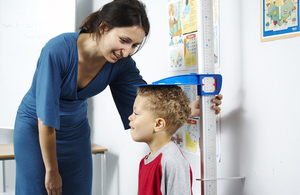Latest PHE National Child Measurement Programme figures available
Latest figures show obesity levels in 4 to 5 year old children have levelled out, and levels in 10 to 11 year old children have stabilised.

Latest annual figures from the NCMP show obesity levels amongst 4 to 5 year old children have levelled out (to 9.3% compared with 9.5% in 2011 to 2012), and levels in 10 to 11 year old children have stabilised (18.9% compared with 19.2% in 2011 to 2012) for the first time since the programme started.
There is, however, a wide gap in obesity rates between the most deprived and the least deprived children, with rates in the most deprived areas double that of the least deprived (12.1% versus 6.4% for 4 to 5 year olds, and 24.2% versus 13% for 10 to 11 year olds).
The NCMP involves the annual weighing and measuring in schools of all eligible children in Reception and Year 6 – for the first time information is available dating back to when children first entered the programme and have now reached Year 6 – giving a much more accurate indication of children’s health throughout this period. More than one million children overall participated in the programme this year. PHE has responsibility for supporting local delivery of the NCMP through provision of tools and resources.
Professor Kevin Fenton, National Director for Health and Wellbeing at PHE, said:
This levelling off in obesity levels at both these age groups is really promising. We will be monitoring these trends very closely to see if this can be maintained over future years and have an impact on overall obesity levels in the population.
Maintaining a healthy weight is important for health and happiness during childhood and in adult life. While the results this year are positive, much remains to be done to create a sustained downward trend of obesity levels amongst children, and address health inequalities. Obesity is a dynamic issue with a variety of causes and we must not be complacent in our efforts to encourage and enable parents and their children to lead healthy lifestyles.
This provides us with a clear picture of the scale of child obesity in England, which we use to inform priorities and actions around tackling child obesity. The data also helps local authorities to understand how child obesity affects their local population and determine what actions they can take on a local level.
PHE will publish a more detailed analysis on trends in early 2014, to look at the reasons behind the findings. There are also a number of programmes children and their families can participate in to help them lead healthier lives.
Dr Ann Hoskins, Director for Children, Young People and Families at Public Health England, said:
We are working closely with a wide range of partners with a role in promoting healthy weight in children. Alongside supporting local authorities, this includes working with the School Food Plan to implement their recommendations, such as advising on school food standards, the Youth Sport Trust and Change4Life in rolling out the Change4Life School Sports Clubs. Other partners include Natural England and Play England to promote informal physical activity and the use of green spaces. We also fully support Government guidelines to increase the number of children meeting a minimum of 60 active minutes a day.
This could include a range of activities and play, and parents can join in with family activities such as cycling, swimming or ball games. Not only does an active lifestyle help to achieve and maintain a healthy weight, but also results in other health benefits such as better fitness, mental health and sleep patterns.
For more advice on leading a healthy lifestyle, parents can access ideas and recipes from the Change4Life website.
Notes to editors
- Public Health England’s mission is to protect and improve the nation’s health and to address inequalities through working with national and local government, the NHS, industry and the voluntary and community sector. PHE is an operationally autonomous executive agency of the Department of Health.
- Until March 2013, primary care trusts were responsible for delivering the programme, but on 1 April 2013 local authorities became responsible for NCMP. PHE is working with local authorities to support them in delivering the programme.
-
The NCMP was established in 2005, and involves the annual weighing and measuring in schools of all eligible children in Reception year (4 to 5 year olds) and Year 6 (10 to 11 year olds). Its 2 main aims are to:
- provide robust, local public health surveillance data on child weight status: to understand prevalence of obesity and trends at a local and national level
- provide parents with feedback on their child’s weight status: to help them understand their child’s health status, support and encourage behaviour change and provide a mechanism for direct engagement with families with overweight and obese children
-
Since 2005, nearly 7 million children have participated in the NCMP, and the programme holds National Statistics status and is regarded as a world-class source of information.
- The data is available from the Health & Social Care Information Centre website.
UK Health Security Agency press office
10 South Colonnade
London
E14 4PU